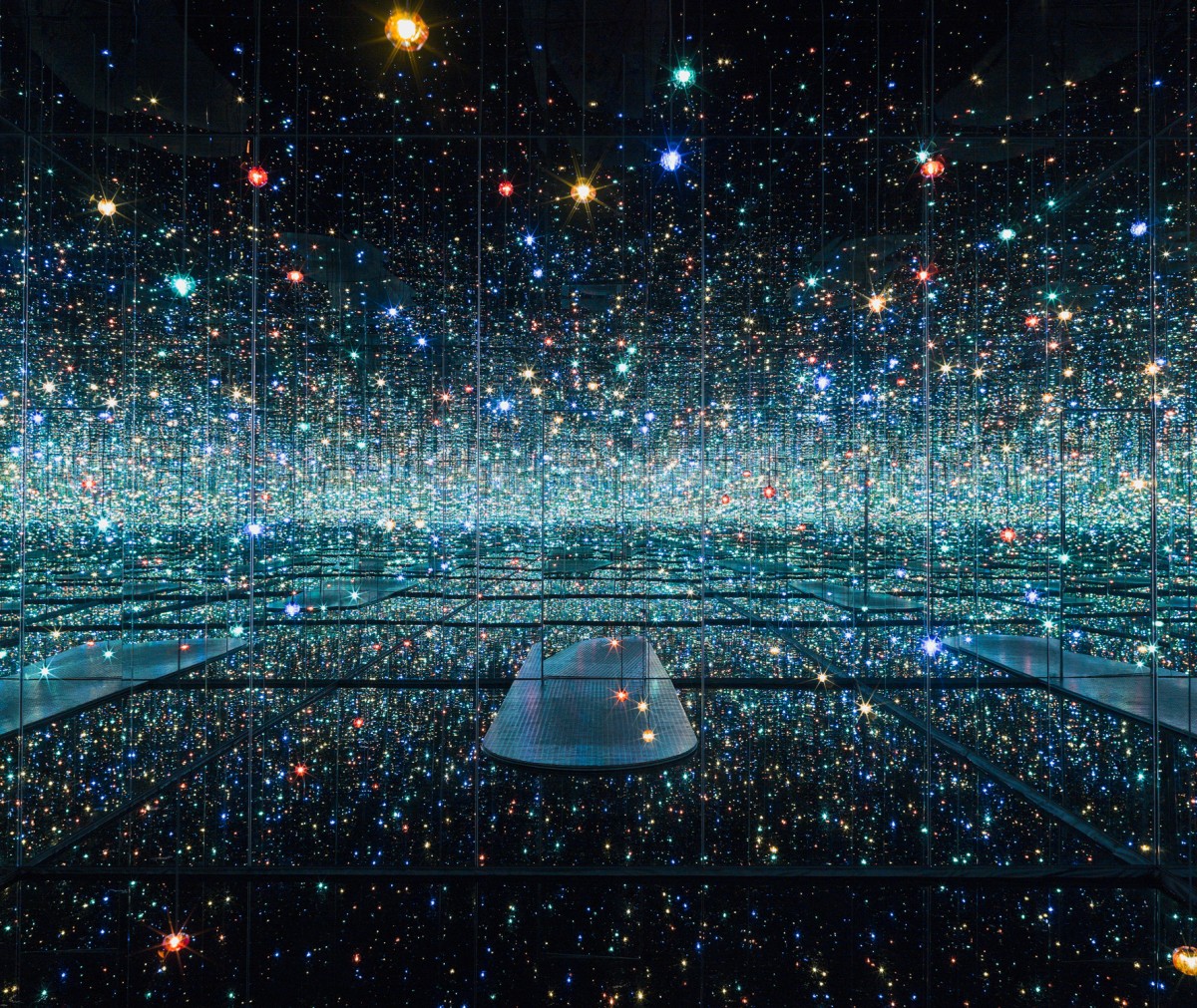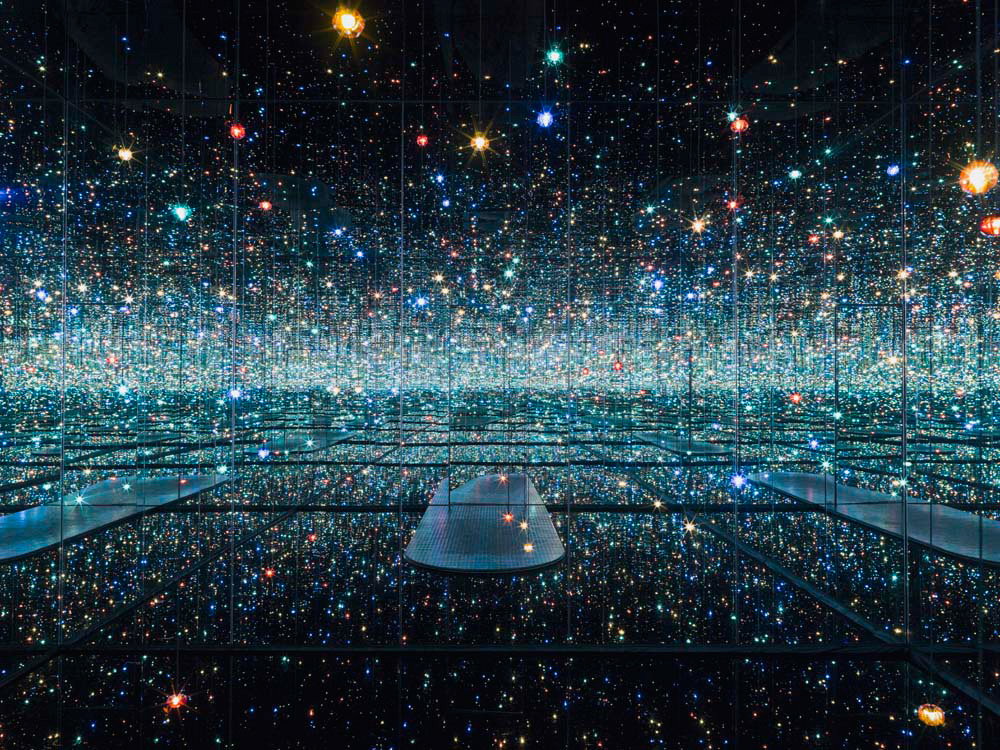 Image from: https://www.thebroad.org/art/yayoi-kusama/infinity-mirrored-room-souls-millions-light-years-away
Image from: https://www.thebroad.org/art/yayoi-kusama/infinity-mirrored-room-souls-millions-light-years-away
Yayoi Kusama, born March 22 , 1929, grew up as the youngest of four children in an affluent family. She is a Japanese contemporary artist who was a self-described “obsessional artist,” known for her extensive use of polka dots and for her infinity installations. Her father, spent most of his time away from home womanizing, leaving his angry wife to physically abuse and emotionally torment her youngest child.Kusama began painting as a child, as a coping mechanism from hallucinations she began experiencing that often involved fields of dots. Those hallucinations and the theme of dots would continue to inform her art throughout her career. Obsessive repetition continued to be a theme in Kusama’s sculpture and installation which were the primary forms of her artwork. Kusama was also inspired by artists across a variety styles including pop, minimalism, and surrealism.The artwork I chose for this hyper essay is Yayoi Kusama’s infinity room, specifically, the one titled The Souls of Millions of Light Years Away.
Introduced in the 1960s, the Infinity mirrored rooms are interactive, large-scale pieces invite viewers to wander through surreal environments. Although it is different from her famous polka dot patterns, the concept of repetition is reflected in her infinity rooms.A room is completely covered with mirrored walls and filled with thousands of small LED lights hang from the ceiling ,which appear as pulsating dots. The floor is covered in a shallow pool of water, except for the standing area in the middle.As the multitude of lights reflect, they accumulate and expand exponentially. It is a mesmerising immersive artwork that surrounds the viewer and encourages them to explore space and time. The closest thing to experiencing these artworks in person, would be a virtual reality simulation that would replicate its visual elements within a headset. The 360-degree experiences of Kusama’s “Infinity” rooms are similar to VR technology. By leaving the space of ones usual sensibilities in the ‘real world’,one enters into communication with a space that is physically innovating, in turn creating an alternate reality for the viewers. Infinity may be a difficult concept to grasp, but it is easy to contemplate when you step inside one of artist Yayoi Kusama’s iconic Infinity Mirror Rooms. It’s her way of describing the experience of being alive, because the concept of infinity reflects the idea of locating yourself as an individual within an infinite time and space. After all, her art depicts the psychotic hallucinations Kusama has endured since a childhood of abuse and neglect. “I felt as if I had begun to self-obliterate, to revolve in the infinity of endless time … and be reduced to nothingness,”.It’s almost as though you’ve been instantly transported from a gallery into Kusama’s obsessive mind.
When you peer over the solid platform inside the room, your knees wobble and your stomach sinks, as the sides of your vision blur, your image is reflected across the mirrored planes, and you lose the certainty of where your skin ends and the art begins.With her mirrored rooms, she seizes control of the gaze to disorient viewers. She wanted to shift the focus away from the viewers having an authorial master perspective.Power, authority and totalitarian regimes were being questioned.It allows one to reflect on their relativity within this vast universe and be able to be represented or even at peace with the insignificance of yourself in relation to it. That destabilisation of perspective and maybe even fragmentation of the self was something that was very much embraced. The quiet, meditative space is a reflection on life and the inevitability of death- subjects that have fascinated Kusama since she was a child. She explains that her work “does battle at the boundary between life and death, questioning what we are and what it means to live and die”.The seams of the mirrored walls blend in with the hanging lights, gets you the closest to obliteration, with the lights even shutting off completely during your stay—but flicker back to life, lest you feel totally expunged.The lights and objects in the rooms represent her anchors to reality as Kusama guides you along her stand about self-annihilation. By encouraging visitors to contemplate their existence the artwork emphasises the interconnectedness we have to each other and the universe. Kusama said,”By using light, their reflection, and so on, I wanted to show the cosmic image beyond the world where we live”. Infinity is an impossible concept, And the flip side of infinity is mortality, and so her work is about confronting and overcoming that we as human beings are bound to die.
Word count:764
Bibliography:
https://www.theartstory.org/artist-kusama-yayoi.htm
https://uk.phaidon.com/agenda/art/articles/2017/october/19/when-yayoi-kusama-created-her-first-ever-infinity-room/
https://gizmodo.com/explore-the-extraordinary-glittering-infinity-rooms-of-1471382304
https://www.theartstory.org/artist-kusama-yayoi.htm
